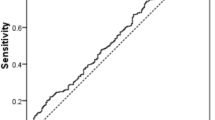Abstract
Purpose
The aim of this study is to evaluate the correlation between serum estradiol (E2) levels during artificial autologous frozen embryo transfer (FET) cycles and ongoing pregnancy/live birth rates (OP/LB).
Methods
A historical cohort study was conducted in an academic setting in order to correlate peak and average estradiol levels with ongoing pregnancy/live birth rates for all autologous artificial frozen embryo transfer cycles performed from 1/2011 to 12/2014.
Results
Average and peak E2 levels from 110 autologous artificial FET cycles from 95 patients were analyzed. Average E2 levels were significantly lower in cycles resulting in OP/LB compared to those that did not (234.1 ± 16.6 pg/ml vs. 315 ± 24.8 pg/ml, respectively, p = 0.04). Although peak E2 levels were not significantly different between cycles resulting in OP/LB compared with those that did not (366.9 ± 27.7 pg/ml vs. 459.1 ± 32.3 pg/ml, respectively, p = 0.19), correlation analysis revealed a statistically significant (p = 0.02) downward trend in OP/LB rates with increasing peak E2 levels.
Conclusions
This study suggests that elevated E2 levels in artificial autologous FET cycles are associated with lower OP/LB rates. Estradiol levels should be monitored during artificial FET cycles.


Similar content being viewed by others
References
Sunderam S, Kissin DM, Crawford SB, Folger SG, Jamieson DJ, Warner L, et al. Assisted reproductive technology surveillance—United States, 2013. MMWR Surveill Summ. 2015;64(11):1–25. doi:10.15585/mmwr.ss6411a1.
Groenewoud ER, Cantineau AE, Kollen BJ, Macklon NS, Cohlen BJ. What is the optimal means of preparing the endometrium in frozen-thawed embryo transfer cycles? A systematic review and meta-analysis. Hum Reprod Update. 2013;19(5):458–70. doi:10.1093/humupd/dmt030.
Shapiro BS, Daneshmand ST, Garner FC, Aguirre M, Hudson C, Thomas S. Evidence of impaired endometrial receptivity after ovarian stimulation for in vitro fertilization: a prospective randomized trial comparing fresh and frozen-thawed embryo transfer in normal responders. Fertil Steril. 2011;96(2):344–8. doi:10.1016/j.fertnstert.2011.05.050.
Check JH, Choe JK, Katsoff D, Summers-Chase D, Wilson C. Controlled ovarian hyperstimulation adversely affects implantation following in vitro fertilization-embryo transfer. J Assist Reprod Genet. 1999;16(8):416–20.
Zhu D, Zhang J, Cao S, Zhang J, Heng BC, Huang M, et al. Vitrified-warmed blastocyst transfer cycles yield higher pregnancy and implantation rates compared with fresh blastocyst transfer cycles—time for a new embryo transfer strategy? Fertil Steril. 2011;95(5):1691–5. doi:10.1016/j.fertnstert.2011.01.022.
Pijnenborg R, Vercruysse L, Hanssens M. The uterine spiral arteries in human pregnancy: facts and controversies. Placenta. 2006;27(9–10):939–58. doi:10.1016/j.placenta.2005.12.006.
Fritz R, Jain C, Armant DR. Cell signaling in trophoblast-uterine communication. The International journal of developmental biology. 2014;58(2–4):261–71. doi:10.1387/ijdb.140011da.
Villee CA, Hagerman DD. Effects of estradiol on the metabolism of human placenta in vitro. J Biol Chem. 1953;205(2):873–82.
Albrecht ED, Aberdeen GW, Pepe GJ. The role of estrogen in the maintenance of primate pregnancy. Am J Obstet Gynecol. 2000;182(2):432–8.
Simon C, Cano F, Valbuena D, Remohi J, Pellicer A. Clinical evidence for a detrimental effect on uterine receptivity of high serum oestradiol concentrations in high and normal responder patients. Hum Reprod. 1995;10(9):2432–7.
Forman R, Fries N, Testart J, Belaisch-Allart J, Hazout A, Frydman R. Evidence for an adverse effect of elevated serum estradiol concentrations on embryo implantation. Fertil Steril. 1988;49(1):118–22.
Arslan M, Bocca S, Arslan EO, Duran HE, Stadtmauer L, Oehninger S. Cumulative exposure to high estradiol levels during the follicular phase of IVF cycles negatively affects implantation. J Assist Reprod Genet. 2007;24(4):111–7. doi:10.1007/s10815-006-9101-x.
Farhi J, Ben-Haroush A, Andrawus N, Pinkas H, Sapir O, Fisch B, et al. High serum oestradiol concentrations in IVF cycles increase the risk of pregnancy complications related to abnormal placentation. Reprod BioMed Online. 2010;21(3):331–7. doi:10.1016/j.rbmo.2010.04.022.
Imudia AN, Awonuga AO, Doyle JO, Kaimal AJ, Wright DL, Toth TL, et al. Peak serum estradiol level during controlled ovarian hyperstimulation is associated with increased risk of small for gestational age and preeclampsia in singleton pregnancies after in vitro fertilization. Fertil Steril. 2012;97(6):1374–9. doi:10.1016/j.fertnstert.2012.03.028.
Zeger SL, Liang KY, Albert PS. Models for longitudinal data: a generalized estimating equation approach. Biometrics. 1988;44(4):1049–60.
Zhang S, Lin H, Kong S, Wang S, Wang H, Wang H, et al. Physiological and molecular determinants of embryo implantation. Mol Asp Med. 2013;34(5):939–80. doi:10.1016/j.mam.2012.12.011.
Paulson RJ. Hormonal induction of endometrial receptivity. Fertil Steril. 2011;96(3):530–5. doi:10.1016/j.fertnstert.2011.07.1097.
Patel S, Kilburn B, Imudia A, Armant DR, Skafar DF. Estradiol elicits proapoptotic and antiproliferative effects in human trophoblast cells. Biol Reprod. 2015;93(3):74. doi:10.1095/biolreprod.115.129114.
Ma WG, Song H, Das SK, Paria BC, Dey SK. Estrogen is a critical determinant that specifies the duration of the window of uterine receptivity for implantation. Proc Natl Acad Sci U S A. 2003;100(5):2963–8. doi:10.1073/pnas.0530162100.
Albrecht ED, Bonagura TW, Burleigh DW, Enders AC, Aberdeen GW, Pepe GJ. Suppression of extravillous trophoblast invasion of uterine spiral arteries by estrogen during early baboon pregnancy. Placenta. 2006;27(4–5):483–90. doi:10.1016/j.placenta.2005.04.005.
Reed BG, Carr BR. The normal menstrual cycle and the control of ovulation. In: De Groot LJ, Chrousos G, Dungan K, Feingold KR, Grossman A, Hershman JM et al., editors. Endotext. South Dartmouth: MDText.com, Inc.; 2000.
Hoff JD, Quigley ME, Yen SS. Hormonal dynamics at midcycle: a reevaluation. J Clin Endocrinol Metab. 1983;57(4):792–6. doi:10.1210/jcem-57-4-792.
Remohi J, Ardiles G, Garcia-Velasco JA, Gaitan P, Simon C, Pellicer A. Endometrial thickness and serum oestradiol concentrations as predictors of outcome in oocyte donation. Hum Reprod. 1997;12(10):2271–6.
Niu Z, Feng Y, Sun Y, Zhang A, Zhang H. Estrogen level monitoring in artificial frozen-thawed embryo transfer cycles using step-up regime without pituitary suppression: is it necessary? J Exp Clin Assist Reprod. 2008;5:4. doi:10.1186/1743-1050-5-4.
Ghobara T, Vandekerckhove P. Cycle regimens for frozen-thawed embryo transfer. The Cochrane database of systematic reviews. 2008;1:CD003414. doi:10.1002/14651858.CD003414.pub2.
Acknowledgements
The authors would like to thank Xiaonan (Nan) Xue, Director, Biostatistics Shared Resource, at Albert Einstein Cancer Center, for her statistical guidance.
Author information
Authors and Affiliations
Corresponding author
Rights and permissions
About this article
Cite this article
Fritz, R., Jindal, S., Feil, H. et al. Elevated serum estradiol levels in artificial autologous frozen embryo transfer cycles negatively impact ongoing pregnancy and live birth rates. J Assist Reprod Genet 34, 1633–1638 (2017). https://doi.org/10.1007/s10815-017-1016-1
Received:
Accepted:
Published:
Issue Date:
DOI: https://doi.org/10.1007/s10815-017-1016-1




